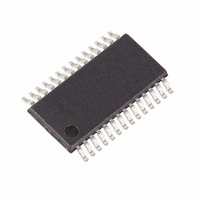MAXQ3181-RAN+ Maxim Integrated Products, MAXQ3181-RAN+ Datasheet - Page 60

MAXQ3181-RAN+
Manufacturer Part Number
MAXQ3181-RAN+
Description
IC AFE POLYPHASE LO-PWR 28-TSSOP
Manufacturer
Maxim Integrated Products
Datasheet
1.MAXQ3181-RAN.pdf
(84 pages)
Specifications of MAXQ3181-RAN+
Number Of Channels
8
Power (watts)
35mW
Voltage - Supply, Analog
3.3V
Voltage - Supply, Digital
3.3V
Package / Case
28-TSSOP
Lead Free Status / RoHS Status
Lead free / RoHS Compliant
Number Of Bits
-
Low-Power, Active Energy, Polyphase AFE
• Divide the applied value (in meter unit) by the value
• Multiply the calculated value by 2
When the gain value is programmed, wait for approxi-
mately 2 to 3 seconds, then reread the RMS value from
A.IRMS. Check that the measured value is correct by
comparing A.IRMS against the applied current in meter
unit.
Phase offset calibration should be performed after the
voltage and current gains have been calibrated. To cal-
ibrate the phase offset, it is first necessary to measure
the power reported by the meter at two different phase
points. The best way to do this is to rely on the pulse
output of the meter; use a precise counter to determine
the power reported by the meter by counting the pulse
period. A load of power factor 0.5L or 0.5C is a good
choice for calibrating phase offset.
1) Apply a known pure resistive load to the meter.
2) Shift the phase of the current by +60° (power factor
3) The phase offset PA
4) Solve for PA from one of the above equations.
5) Convert PA into integer number, by multiplying it by
6) Convert to hex value and write to the appropriate
60
read from the MAXQ3181. The result should be a
value between 0 and 2. If the value falls outside of
this range, you have probably miscalculated I
gain value to be programmed into A.I_GAIN. Ensure
the most significant bit is 0.
Read the measured power, as P
of 0.5C). Read the measured power, as P
equation:
If an inductive load (PF = 0.5L) is applied, the
phase offset equation becomes:
These equations can be expressed in terms of rela-
tive errors, where E
power relative errors at PF = 1.0, 0.5C, and 0.5L
respectively.
2
register.
______________________________________________________________________________________
16 .
tan(PA
tan(PA
tan(
tan(
PA
PA
0.5C
0.5L
0 5
0 5
.
.
) = (1 - 2P
) = (2P
L
Calibrating Phase Offset
C
1.0
)
)
0.5C
=
=
, E
−
E
0.5L
E
1 0
0.5C
3 1
3 1
1 0
.
is computed from the
(
.
(
0.5C
/P
−
+
+
+
, and E
E
1.0
1.0
E
14
E
E
0 5
/P
1 0
1 0
0 5
. The result is the
.
.
.
.
- 1)/
1.0
.
C
)
)
L
)/
0.5L
0.5C
3
3
FS
are the
.
.
Note that MAXQ3181 supports three offset values—
X.PA2, X.PA1, and X.PA0—corresponding to the low,
mid, and high range of the input signals, respectively.
Calibrating at the three loading levels could become
necessary if the phase error introduced by the current
sensors varies significantly with the input levels.
Registers I1THR and I2THR define the limits of the
ranges. If I1THR and I2THR are left at their default val-
ues of 0x0000, X.PA0 is applied to the full input range.
Phase Offset Calibration Example
Make sure X.PA0, X.PA1, and X.PA2 are cleared before
proceeding with calibrations. Assume the phase A has
been calibrated for A.VGAIN and A.IGAIN at Ib (= 10A).
At PF = 1.0, the active power relative error is E
-0.4%. Set input to I = Ib and PF = 0.5L. The relative
error reported by the meter tester is E
for PA
where PA
X.PA0 = 0.009274437 x 2
Write 0x260 to A.PA0 (address 0x13E). If multirange
calibration is required, repeat the above procedure at
the desired input levels. The input levels for calibration
should be selected based the phase error characteris-
tics of the current sensors.
The MAXQ3181 has all the internal circuitry that is
needed for a sophisticated electricity meter, but specif-
ic external hardware is required when configuring the
meter for a particular application. The most critical
decision that must be made is how the load will be con-
nected to the power source, and how the meter will be
connected to measure power consumed in the load.
This section covers how to select hardware compo-
nents for a MAXQ3181 electricity meter.
Figure 15. Offset Testing Setup
tan(
PA
NEUTRAL
0.5L
0 5
.
LINE
L
Interfacing the MAXQ3181 to
)
0.5L
from the following equation:
=
−
E
3 1
1 0
= 0.009274437 (radians) = 0.53° and
.
(
+
+
E
E
LOAD
1 0
0 5
.
.
)
L
=
16
External Hardware
0 4 100 1
. /
(
1 0 4 100 3
= 607.8095 = 0x0260.
−
. /
METER
V
LAB
+ 2 2 100
.
)
0.5L
/
= 1.2%. Solve
=
0 009274703
V
UNDER
.
TEST
UNIT
1.0
=











